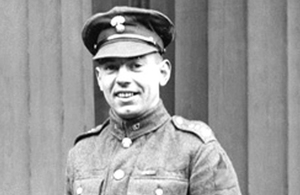WW1 Canadian VC recipient John Francis Young
The story of Canadian First World War Victoria Cross recipient John Francis Young.

John Francis Young [Credit: National Defence Canada]
70 men from Canada received the Victoria Cross, Britain’s highest award for gallantry, during the First World War. As part of the Centenary Commemorations the people of the United Kingdom marked their gratitude to those courageous men by presenting a bronze memorial plaque to their home country engraved with their names. The plaque is now displayed at the British High Commission Ottawa. This archive tells their stories
Name: John Francis Young
DOB: 14 January 1893
Place of Birth: Kidderminster, England
Date of Action: 2 September 1918
Place of Action: Drocourt-Queant Line, Near Dury, France
Rank: Private
Regiment: 87th Infantry Battalion, Canadian Expeditionary Force
John Francis Young was born on 14 January 1893 in Kidderminster, England. He emigrated to Canada before the First World War, where he worked in Montreal for a tobacco company. At the start of the First World War Young joined the 87th Infantry Battalion, Canadian Expeditionary Force, serving as a stretcher bearer.
It was on 2 September 1918 when his company suffered heavy casualties on the Drocourt-Queant line near Dury, France, when Private Young’s actions led to him being awarded the Victoria Cross. His citation explains in detail:
For most conspicuous bravery and devotion to duty in attack at Dury-Arras sector on the 2nd September, 1918, when acting as a stretcher-bearer attached to ‘D’ Company of the 87th Bn., Quebec Regiment. This company in the advance over the ridge suffered heavy casualties from shell and machine-gun fire.Pte. Young, in spite of the complete absence of cover, without the least hesitation went out, and in the open fire-swept ground dressed the wounded. Having exhausted his stock of dressings, on more than one occasion he returned, under intense fire, to his company headquarters for a further supply. This work he continued for over an hour, displaying throughout the most absolute fearlessness. To his courageous conduct must be ascribed the saving of the lives of many of his comrades. Later, when the fire had somewhat slackened, he organised and led stretcher parties to bring in the wounded whom he had dressed. All through the operations of 2nd, 3rd, and 4th September Pte. Young continued to show the greatest valour and devotion to duty.
Private Young returned to Canada after the war, returning to his previous job in Montreal, and still retaining a connection to the military. He died in 1929 in Quebec.